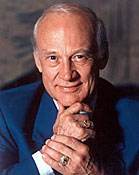
Buzz Aldrin
National Space Society Board of Governors
Buzz Aldrin is best known as the second man to set foot on the Moon. His interest in space flight began at home. His parents, Marion Moon and Edwin Eugene Aldrin, were intimately connected with early space flight, as his father was a student of rocket pioneer Robert Goddard. Dr. Aldrin received his undergraduate education at West Point, graduating with honor in 1951. After receiving his wings, he flew Sabre Jets in 66 combat missions in Korea. He has also earned a doctorate in Astronautics from MIT in Manned Space Rendezvous, where his innovations in Manned Space Rendezvous techniques continue to be standard procedure to this day.
In 1963, NASA chose Dr. Aldrin to become one of its Group 3 astronauts. His first spaceflight was on the Gemini 12 mission, where he made major improvements by advancing operational techniques for spacewalking and astronautical navigation star display. Dr. Aldrin is most famous, however, for his assignment as lunar module pilot on Apollo 11, the historic first lunar landing-mission in July 1969. His responsibilities included monitoring lunar module systems while commander Neil Armstrong concentrated on landing. After Dr. Aldrin joined Mr. Armstrong on the surface of the Moon, they set up science experiments and gathered rock samples.
Dr. Aldrin has authored Men From Earth and Return to Earth based on his astronaut experience. In 1996, he co-authored his first science fiction novel with John Barnes, Encounter with Tiber. Their second novel, The Return, a technothriller about the real vulnerabilities of the nation’s space program, was published in 2001.
Dr. Aldrin has received the Presidential Medal of Freedom and more than 50 other distinguished awards. He is President of Starcraft Enterprises and has made numerous television appearances spanning the media’s full scope of entertainment, including David Letterman, Rosie O’Donnell, Larry King Live, CNN, and all the major networks. He continues to work towards sustained space exploration, designing both space stations and unique systems such as “The Cycler,” a space complex that would orbit perpetually between the Earth and Mars.







